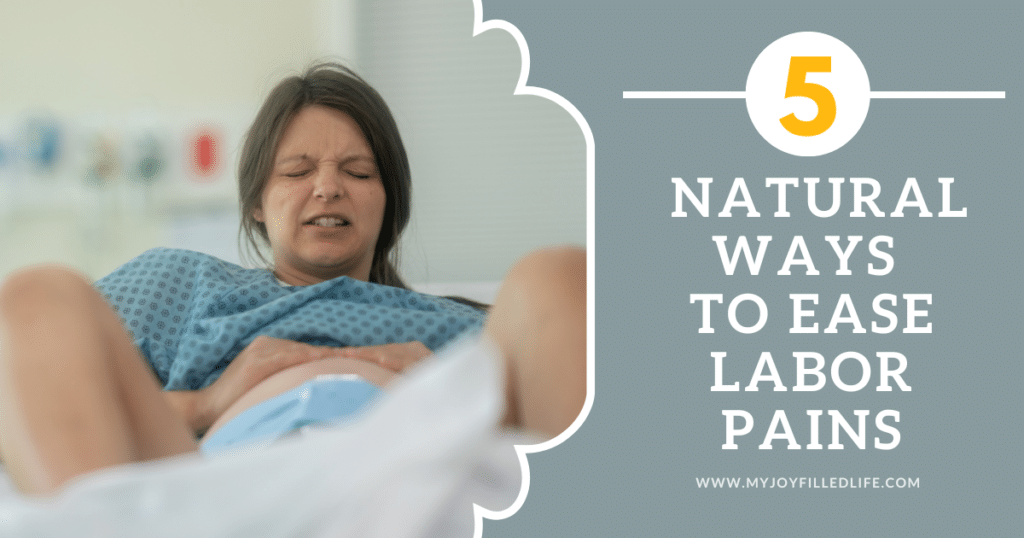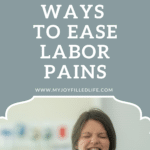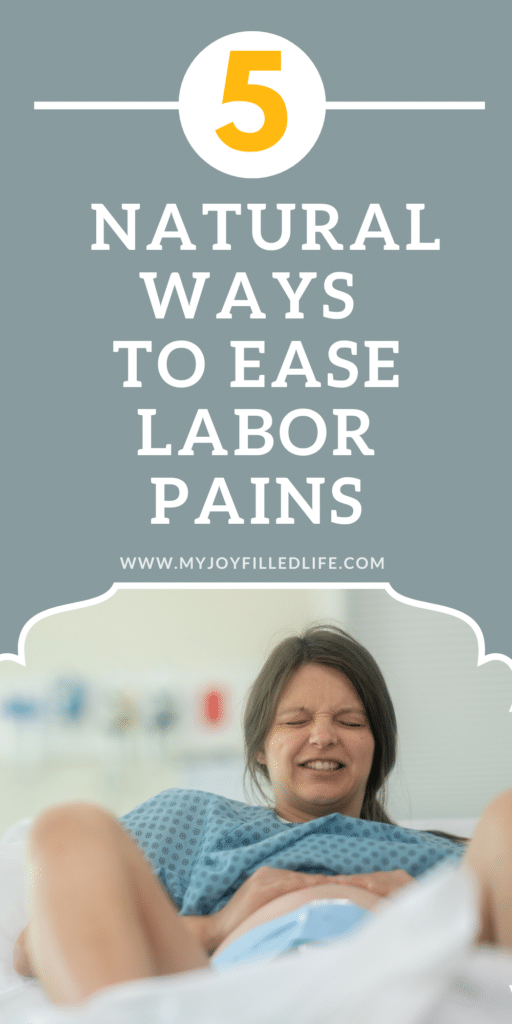Childbirth is an incredibly beautiful experience. I’m blessed to have experienced giving birth eight times. Whether it’s your first pregnancy, or your fifth, you’re likely feeling a mix of emotions, from excitement to a bit of apprehension, especially when it comes to labor and delivery. You’re probably trying to decide if you’ll use any kind of pain medication during labor, or if using more natural forms of pain management is the way you’d prefer to go.
After my first three children were born with the help of an epidural to control my pain (along with Pitocin, which from my experience makes the pain much worse), I decided that for my fourth time around, I wanted to go with as little medical intervention as possible. That meant no induction (Pitocin) and no pain medications of any kind.
If you’re hoping to have a natural birth like I was and are wondering how you can help ease and control the pain that childbirth can bring, keep reading to explore several natural ways to ease labor pains during childbirth.

The Importance of a natural Birth
One of the significant benefits of natural birth is reducing medical interventions as much as possible such as epidurals, inductions, and cesarean sections. These interventions, while sometimes necessary, can come with risks and side effects. By opting for a natural birth, mothers can avoid potential complications associated with these medical procedures, such as infections or longer recovery times.
Natural Childbirth the Bradley Way




Benefits of Natural childbirth
Using natural methods to manage labor pain has several benefits:
- Reduced risk of interventions such as C-sections and forceps deliveries.
- Faster recovery post-birth, allowing mothers to bond with their newborns more quickly.
- Increased satisfaction with the birthing experience.
- Enhanced sense of control and active participation during labor and delivery.
- Fewer side effects for both the mother and baby.
Natural Labor Tools:
The Peanut Ball: Basic and Advanced Techniques for Use During Labor and Delivery





Natural Ways to Ease Labor Pains
Water Therapy
Warm water can be incredibly soothing and a very effective way to relieve labor pains. There are several ways you can incorporate water into your birth plan.
Soaking in a warm bath can help you relax and relieve tension in your muscles. A warm shower can have a similar effect. If you have a fancy shower head that changes pressure and speed, you can adjust that and aim it at your lower back to help with any back labor you may experience. And finally, a birthing pool is a great option if you have the space for one. The buoyancy of the water can support your weight, making it easier to move and find comfortable positions.
Movement & positioning
Changing positions and staying mobile can significantly reduce labor pain. Walking, swaying, rocking, sitting or bouncing on a birthing ball, or changing positions can help labor progress and make contractions more manageable. Changing positions can also help your baby move into an optimal position for birth.
Positions and movements to consider:
- Take a walk – While in the early stages of labor, before your water breaks, get up and move about. Walk around the hospital floor but of course don’t get too far from your room. Walking the corridors of the hospital can stretch your muscles as they are tightening up and cramping from labor.
- Swaying – Gently swaying your hips can help your baby move down into the birth canal and relieve pressure on your back.
- Squatting – Squatting during labor can help widen the pelvis, allowing more room for the baby to descend. This position also uses gravity to aid in the birthing process. Many women find that squatting provides relief from pain and pressure, making it a favorable position during contractions.
- Hands & Knees – This position allows some weight to spread out and gives you range to rock back and forth. The rocking motion enhances vibration to ease the contractions and help you get to the in-between breaks. Your partner can also reach your back, thighs, hips or bottom to gently massage where the pressure may be most severe.
- Birthing Ball – Sitting on a birthing ball and gently bouncing or rocking can alleviate back pain and help open your pelvis.
Breathing
Breathing is a powerful tool for managing pain and staying calm during childbirth. It’s a simple and effective way to manage labor pain naturally. Breathing deeply and rhythmically can help you stay relaxed and reduce your perception of pain.
Keeping a good breathing pattern with deep breaths will help conserve your energy, ease the pain, and provide plenty of oxygen to you and your baby. Have a plan with your partner on breathing and how to remind you to keep the oxygen flowing.
Massage, Pressure, & Heat
Massage and counter-pressure can relieve tension and reduce pain in specific areas like the lower back, hips, and shoulders.
- Back Massage – Ask your partner to gently massage your lower back, especially during contractions. Massage can reduce pain by increasing the release of endorphins, your body’s natural painkillers.
- Counter-pressure – Have your partner apply firm pressure to your lower back during contractions.
- Foot and Hand Massage – Massaging of your hands and feet, or any other body part that is tense, can be incredibly soothing and an effective distraction from the contractions.
- Heating Pad – Placing a heating pad on tense or sore muscles, especially in the the lower back, can help tremendously easy pain and relax muscles. You can purchase one online, or you can easily make your own rice heating pad. It’s great for post-partum use too.
The physical connection and support from your birthing partner can provide both emotional and physical comfort.
Prayer & Meditation
Prayer during childbirth and labor can be a powerful and comforting tool. Through prayer, women can concentrate and focus and receive strength from the Lord.
Meditating on certain things can also help provide calm and peace, like reminding yourself that your body was made to do this, or imaging yourself holding your baby for the first time.
Incorporating prayer into your childbirth plan can be as simple as saying a short prayer repeatedly, reciting scripture to yourself or out loud, listening to calming spiritual music, or seeking prayer and support from your church family.
Praying Through Your Pregnancy: A Week-by-Week Guide

The key to a positive labor is to be educated and prepared for any pain or situations that may arise. By exploring these natural pain relief methods, you can approach labor with more confidence and a toolkit of strategies to help you through the process.
Each of these techniques can play a crucial role in making your childbirth experience more comfortable and fulfilling. It’s all about finding what works best for you and your unique birthing experience. And remember, birth is unpredictable, and everything might not go as you hoped or planned, and that’s okay. The most important thing is that in the end, you have a healthy mom and baby.























Leave a Reply